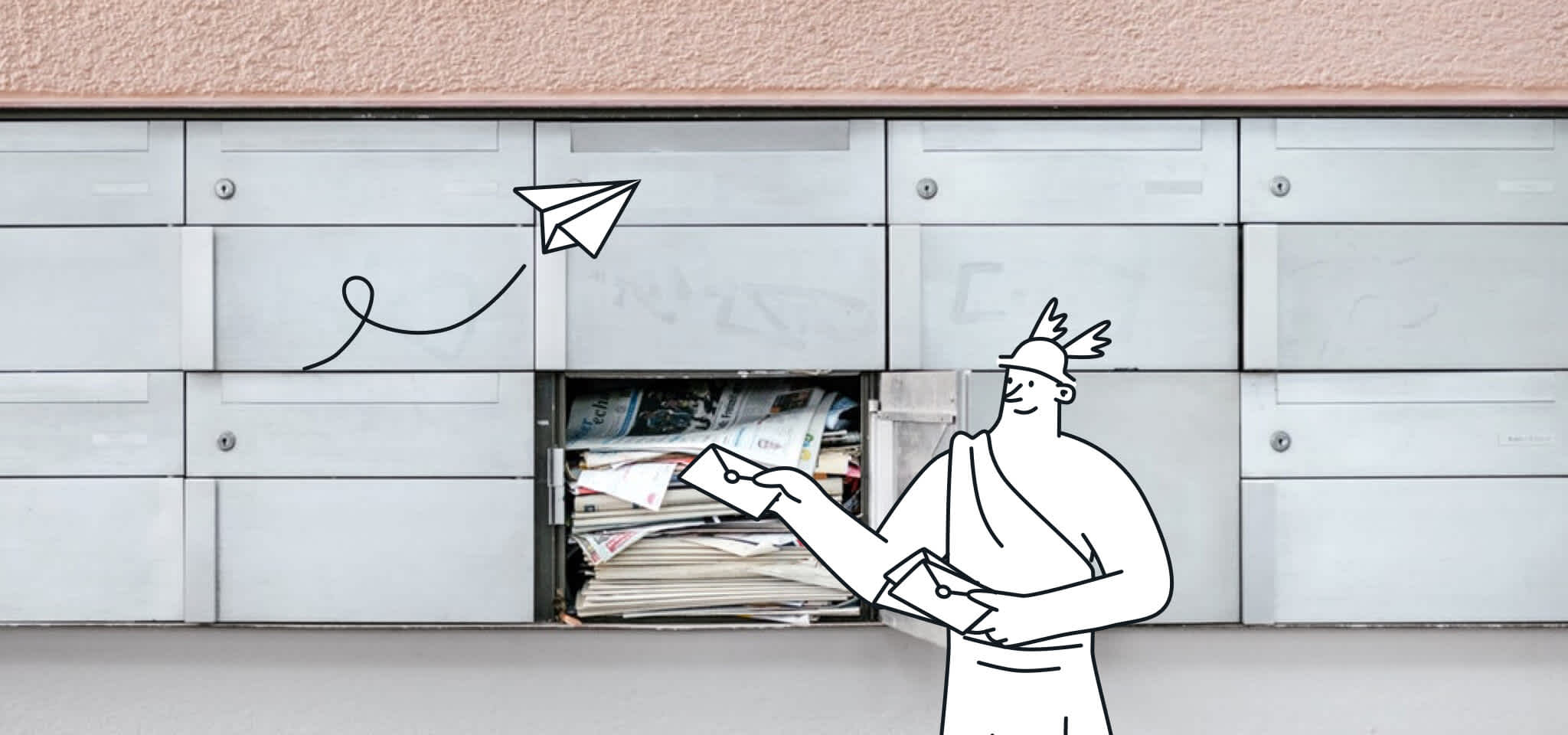Deliverability
Email deliverability: A how-to guide to get into the inbox
Email deliverability is important for your business. Here are the insider ins and outs to ensure your emails hit your customer's inbox, not spam folder.

PUBLISHED ON
How often do you check your spam folder? Almost never? Then how do you know that important emails aren’t in your spam folder? Do you just trust your Internet Service Provider (ISP)? Well, your ISP - whether this is Gmail, Outlook, Yahoo, or the now-defunct Mailbox (RIP) - doesn’t just magically sort out what email goes to your inbox and what doesn’t. And there’s no guarantee that your important emails get sent to your inbox. And vice-versa. Nothing in life is ever that simple. It’s a process related to something called email deliverability.
That doesn’t sound like a sexy buzzword. And it isn’t. Neither does it effortlessly roll off the tongue. De-li-ve-ra-bi-li-ty - a whopping seven syllables that doesn’t even score much on Scrabble (only 24 points). But it’s very important. Please, bear with me.
Table of content
Avoid email spam filters
Have a clear opt-in process or your reputation might suffer
Clean up your list to improve deliverability
Set up your SPF & DKIM
Follow the industry best practices
Use a trusted sender name
What is email deliverability?
Email deliverability looks at the number of emails that go to your list’s inboxes. Deliverability failure is when your emails don’t get into your customers inboxes. Simple enough, right? The process behind ensuring deliverability can be complicated, though. But we will provide you with tips on how to improve your deliverability.
Want to learn even more about deliverability best practices? Download our guide now!
Why does email deliverability matter?
Are you a business that sends emails? Do you want your emails to land in the inbox, and not the spam folder? If yes, then you will have to care about deliverability.
Businesses, especially in eCommerce, typically send two types of emails to their customers.
A. The first type is marketing emails. They’re sent to customers who have opted-in to get emails from that brand. These can include everything from discount emails, weekly newsletters, or Holiday campaigns.
B. The other is transactional emails, which customers receive after they do an action on a website or app, including a registration confirmation, password reset, or a purchase receipt.
If you still haven’t completely figured out why deliverability matters, imagine this.

Email deliverability matters
You’re a bus company. A ticket purchase confirmation email goes into your passenger’s spam folder, which they don’t check quite often or would not even think of checking. This issue happens with say, 1% of your customers. On a week this could happen to thousands more people.
Then, thousands of angry customer complaints flood your company inbox, and your support team can’t handle this outpour. You lose customers to competitors, and it’s turned into a big crisis. And you lose a huge chunk of profit.
If your marketing emails with discounts also get sent to your customers’ spam folders, again you could be losing out on a big proportion of new revenue. It’s also equally annoying for customers who might have wanted to take these discounts.
Scratch that - it’s annoying for everyone.
You can easily avoid these if you carefully consider your email deliverability.
Your customers need to see your business’ important transactional and marketing emails in their inboxes, not spam folders.
What’s the difference between email delivery and deliverability?
Email delivery is whether or not your audience’s ISP (e.g. Gmail) received your emails. Deliverability is on emails that hit the inbox.
There are other key words to consider: sent vs delivered. Delivered emails simply mean that the receiving server has accepted your emails and that the recipients can see them.
But sent emails means that they are still being processed or have been placed in a queue for various reasons (e.g. the recipient’s inbox may be full, or the email address may not be right).
It’s ultimately better to measure your campaign success in terms of deliverability, not delivery. Deliverability indicates whether the types of emails you deliver are good enough to get into your customers’ inboxes, and your sending practices can ultimately impact this. The delivery rate might be on other factors outside your factor, such as your ESP of choice and your bounce and block rates. It's always good to do your due diligence in picking your ESP. In reading this article, you're probably already aware of how seriously Mailjet takes deliverability.
How to improve your email deliverability
Okay great, but how do I actually control deliverability?
Avoid email spam filters
The process of emails getting sorted into either the inbox or spam folder is not as dramatic as Anakin Skywalker becoming Darth Vader. But spam is like the Star Wars prequels - no one wants to see them - ever. And both should never have been made.
In any case, ISPs have similar criteria on email content that can trigger their spam filters. For marketing and transactional emails, these can include simple typos, large attachments, inaccurate sender information, sending your emails out to inactive addresses, and the sender having an extensive history of delivered unread emails. So only send emails that people, including you, want to see.
Our marketing team previously wrote this excellent, comprehensive guide on how to avoid various ISPs spam filters, and you should check it out. It’s not only helpful, but also funny. For example, here’s the table of bad words that might trigger spam filters.

Have a clear opt-in process or your reputation might suffer
There’s nothing worse than getting emails no one wants. Now, imagine if someone absentmindedly subscribes to you, only to realize that they actually don’t want to? This could result into an inbox full of unanswered emails you’ve sent. Not good for your sender reputation, which matters a lot in the digital age. If an IP address has poor sender reputation, ISPs could filter this IP’s emails as spam.
Sending reputation can be based on many things, including your email sending history, spam complaints associated with your IP address and spam complaints associated with the domain name.
In any case, it’s always better to have a clear opt-in process. It’s also better to have double opt-in for your subscriptions. Sending an email confirmation email before that person can get your emails will ensure that:
The email is valid.
The email address owner is the one who in fact subscribed.
They really want to get your emails.
Also, it’s also important to include a visible unsubscribe button in your emails. Just do it. Otherwise your customers might flag you as spam. In order to be GDPR and CAN-SPAM compliant, this is mandatory.
If you also introduced the option to mass subscribe customers to other affiliated newsletters, you also better visibly show that mass-unsubscribe option in your emails.
Clean up your list to improve deliverability
Cleaning up your email contact lists can be a good way to make sure that you’re sending emails to active users. It’s like cleaning up your shared kitchen. If you don’t, your roommates will start regretting in having you as their roommate, stop being friends with you, and live elsewhere (or worse: kick you out). If you keep sending emails to a dirty, filthy list, you will get less opens, clicks, and engagement.You send marketing and transactional emails to get that sweet email marketing $40:1 ROI, not to send emails to people won’t ever open them to begin with.
One of Mailjet’s customers, Videostream, came to realize that their email list was not longer clean and their emails were not delivering, not being opened, and certainly not being clicked in the way that it could.
When Videostream shifted over to a Custom Enterprise account, our Technical Account Manager Kyle noticed right away that while their contact list was growing massively (from 200K to 1.2 million contacts), their engagement was flatlining and in fact decreasing.
So, Kyle put them on a plan to clean their list of inactive, “dirty”, contacts and Videostream immediately saw a massive jump in not only open rate but actually total opens. They were sending emails out to their list of 1.2 million contacts but were getting an open rate maxing out at 1.88%. Kyle worked with them to identify inactive contacts, and those getting blocked and bounced to reduce their list from 1.2-million back down to 350K.
The result was a spike in open rates, but most interestingly a spike in total opens by 451%. Less people received the email, but more people opened it. This magic is the result of cleaning your email lists.
Set up your SPF & DKIM
Your Sender Policy Framework (SPF) will ensure that the IP you’re using can send emails on behalf of a domain. Domain Keys Identified Email (DKIM) ensures that the emails you send have not been changed in the process of getting sent (it’s a perilous journey). Set them both up by following our comprehensive guide.
Follow the industry best practices
Following Mailjet's Acceptable Use Policy will optimise your sending. Pictured below are the minimum thresholds we expect from all of our senders. Note that this is not showing the ideal scenario, but instead is showing the rates at which Mailjet’s compliance and deliverability team are flagged to take a look... This is the danger zone.

You should also follow the email legislation in your country for marketing and transactional emails. Otherwise, your emails may get flagged as spam by ISPs, and your deliverability will suffer. Or worse, you might get fined. Not being GDPR-compliant can cost you up to €20 million in fines.
Companies should also avoid resorting to dirty tactics to game the system of various ISPs. For example, don’t try to get your marketing emails into Primary Tab on Gmail, or risk getting flagged as spam. And just don't try to creep into their personal email folder. It's like entering your roommate's room uninvited. It's creepy and not cool.
Use a trusted sender name
Partner with a trusted ESP like Mailjet for your marketing and transactional emails to make sure that your emails hit your customers’ inboxes.
Conclusion
Deliverability can be a tricky and unsexy thing. But the more you learn the ins and outs of email marketing, the more you’ll realize how important this can be in order to really optimize your sending.
The path to great deliverability can be long, confusing and winding, but these tips can help you find your way in sending great email campaigns that hit the inbox.
As always, if you have any more insider tips on how to improve email deliverability, tweet them to us @Mailjet.








